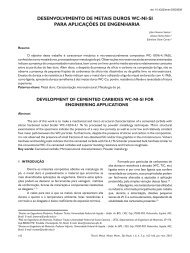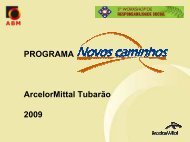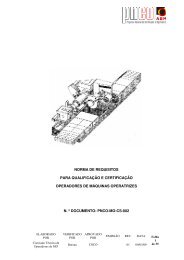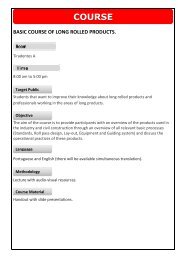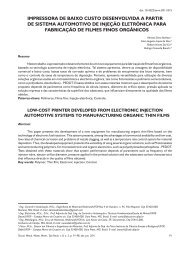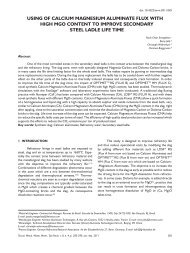Recent Trends in Heat Recovery Cokemaking Processes - ABM
Recent Trends in Heat Recovery Cokemaking Processes - ABM
Recent Trends in Heat Recovery Cokemaking Processes - ABM
You also want an ePaper? Increase the reach of your titles
YUMPU automatically turns print PDFs into web optimized ePapers that Google loves.
<strong>Recent</strong> <strong>Trends</strong> <strong>in</strong> <strong>Heat</strong> <strong>Recovery</strong> Cokemak<strong>in</strong>g<br />
<strong>Processes</strong><br />
Dr. John F. Quanci<br />
SunCoke Energy<br />
Vice-President of Technology<br />
September 2011<br />
September 2011 SunCoke Energy 1
Outl<strong>in</strong>e<br />
• Iron Production: Coke Usage<br />
• <strong>Heat</strong> <strong>Recovery</strong> Cokemak<strong>in</strong>g Technology History<br />
• <strong>Heat</strong> <strong>Recovery</strong> Cokemak<strong>in</strong>g: Current Practice<br />
• Future Requirements and Direction <strong>in</strong> <strong>Heat</strong> <strong>Recovery</strong><br />
September 2011 SunCoke Energy 2
Iron Production: Coke Usage<br />
September 2011 SunCoke Energy<br />
3
Iron Production: Coke M<strong>in</strong>imization<br />
• Coke is the 2 nd highest cost consumable <strong>in</strong> Steel<br />
production<br />
– ~25% of the total cost<br />
– Iron highest at ~40% of total cost<br />
• Blast furnace competitiveness depends on lower<strong>in</strong>g<br />
coke use<br />
• Steel Industry focused on lower<strong>in</strong>g coke use for the<br />
last 50 years by advances <strong>in</strong> practices and technology<br />
September 2011 SunCoke Energy 4
Reduction Blast Furnace Reduc<strong>in</strong>g Agent Consumption<br />
Impact of Technology over the last 50 years:<br />
• Reduc<strong>in</strong>g Agents lowered by over 50%<br />
• Coke use lowered by over 65%<br />
September 2011<br />
consumption of reductants kg/thm<br />
1100<br />
1000<br />
900<br />
800<br />
700<br />
600<br />
500<br />
400<br />
300<br />
200<br />
100<br />
0<br />
Ore beneficiation<br />
Input of overseas rich ores<br />
Blast temperature > 1200C<br />
O2 enrichment<br />
Top pressure<br />
Burden distribution<br />
1950 1955 1960 1965 1970 1975 1980 1985 1990 1995 2000 2005<br />
year<br />
Gas flow control<br />
Improvement of Fe burden<br />
~30%<br />
Improvement of coke<br />
Source: Sponge Iron Production - Chatterjee<br />
Small coke <strong>in</strong> Fe burden<br />
104<br />
33<br />
345<br />
coal<br />
oil + others<br />
coke<br />
482<br />
SunCoke Energy<br />
5
Global Demand for Coke and Hot Metal<br />
Source: US Geological Survey<br />
• Even though Steel Companies driv<strong>in</strong>g down coke/thm through technology and alternate<br />
reductants, coke demand still <strong>in</strong>creas<strong>in</strong>g<br />
• Increas<strong>in</strong>g demand for cok<strong>in</strong>g coals expected<br />
September 2011 SunCoke Energy 6
Alternate Reductants for Coke Replacement<br />
• Increased use of PCI and other reductants to replace coke <strong>in</strong><br />
Blast Furnaces<br />
• As high as 30-40% of blast furnace coke has been replaced by<br />
alternate reductants like PCI<br />
• Alternate reductants could potentially make up as much as<br />
50% of the total reductant<br />
• As alternate reductants like PCI <strong>in</strong>crease, higher quality coke<br />
needed:<br />
– Supports the burden (about 50% of total reductant)<br />
– Distributes gases<br />
• Will drive demand for larger and stronger coke!<br />
September 2011 SunCoke Energy 7
<strong>Heat</strong> <strong>Recovery</strong> Technology History<br />
September 2011 SunCoke Energy 8
Sun Coke<br />
Process Flow Diagram<br />
SunCoke Energy – Process Flow Diagram<br />
Coal 1,930 F Flue Gas temperature<br />
Flue Gas<br />
Treat<strong>in</strong>g<br />
for Sulfur<br />
Removal<br />
ID Fans<br />
Coal - Blended<br />
VM 24.50<br />
FC 68.25<br />
Ash 7.25<br />
Moisture 7.00<br />
<strong>Heat</strong> <strong>Recovery</strong> Coke Ovens<br />
Steam<br />
Extracted<br />
for Process<br />
Use<br />
Turb<strong>in</strong>e<br />
Electricity to Grid<br />
Emergency<br />
Stack<br />
Run-of-Oven<br />
Coke<br />
Furnace coke<br />
Breeze<br />
<strong>Heat</strong> <strong>Recovery</strong><br />
Steam Generators<br />
Co-generation Plant<br />
Condenser<br />
Feed Water<br />
<strong>Heat</strong>ers, Pumps,<br />
Deaerators<br />
September 2011 SunCoke Energy 9<br />
Ma<strong>in</strong> Stack
SunCoke Energy – Horizontal <strong>Heat</strong> <strong>Recovery</strong> Oven<br />
September 2011 SunCoke Energy 10
Horizontal Non-<strong>Heat</strong> <strong>Recovery</strong> – Developmental History<br />
• 1960s<br />
– First SunCoke Horizontal Mitchell Ovens <strong>in</strong> Jewell<br />
• 1970s<br />
– Jewell Thompson ovens built<br />
– Precursor to modern HHR design<br />
• 1980s<br />
– Cont<strong>in</strong>ued R&D<br />
– Highest quality coke <strong>in</strong> US<br />
Jewell Plant – late 1980s<br />
Jewell Plant – Vansant, VA<br />
(Mid-1970s)<br />
September 2011 SunCoke Energy 11
1990s – First Generation <strong>Heat</strong> <strong>Recovery</strong> Plant<br />
• SunCoke builds first heat<br />
recovery plant <strong>in</strong> world<br />
• Located <strong>in</strong> East Chicago, Indiana<br />
• Started up <strong>in</strong> March 1998<br />
• Coke capacity: 1.3M tpa (268<br />
ovens)<br />
• <strong>Heat</strong> <strong>Recovery</strong> of 1.0 Mlbs/hr of<br />
superheated steam<br />
• Rated for 100 MW of power<br />
generation<br />
Indiana Harbor Coke Plant – March 1998<br />
September 2011 SunCoke Energy 12
SunCoke Energy History s<strong>in</strong>ce 2000 – New HR Plants<br />
Domestic Operations<br />
Granite City (2009)<br />
120 Ovens<br />
Capacity: 650kt<br />
Steam: 450klbs/hr<br />
Indiana Harbor<br />
268 Ovens<br />
Capacity: 1,220kt<br />
Steam: 1,000klbs/hr Haverhill (2005, 2008)<br />
200 Ovens<br />
Capacity: 1,100kt<br />
Steam: 450klb/hr<br />
Power: net 46 MW<br />
Jewell Coke<br />
142 Ovens<br />
Capacity: 720kt<br />
Middletown (1)<br />
100 Ovens<br />
Capacity: 550kt<br />
Power: net 46 MW<br />
Exist<strong>in</strong>g coke facilities<br />
Coke facility under construction<br />
(1) Expected start-up <strong>in</strong> Q4 2011.<br />
(2) SunCoke holds a preferred <strong>in</strong>terest of $41 million <strong>in</strong> Vitória and is the operator.<br />
International Operations<br />
Brazil<br />
Vitória (2) (2007)<br />
320 Ovens<br />
Capacity: 1,700kt<br />
Power: 150 MW<br />
September 2011 SunCoke Energy 13
SunCoke <strong>Heat</strong> <strong>Recovery</strong> Plants<br />
Vitoria, ES – Brazil (320 Ovens)<br />
Haverhill, OH – Phase II (100 Ovens)<br />
September 2011 SunCoke Energy 14
Most recent project – Middletown, OH<br />
September 2011 SunCoke Energy 15
SunCoke Energy Capacity through 2011<br />
• Steady <strong>in</strong>crease <strong>in</strong> SunCoke Energy heat recovery cok<strong>in</strong>g capacity over the last 5 – 10 years<br />
• All new coke plants <strong>in</strong> United States s<strong>in</strong>ce 2000 have been Horizontal <strong>Heat</strong> <strong>Recovery</strong><br />
September 2011 SunCoke Energy 16<br />
<strong>Heat</strong> <strong>Recovery</strong> Capacity
Last 5-Year Technology Advancements<br />
• Improved Oven Design<br />
• Improved HRSG design<br />
• Pusher charger mach<strong>in</strong>e upgrades<br />
• Flat push hot car & quench car<br />
• Further enhanced charg<strong>in</strong>g<br />
emission control system<br />
• Advanced FGD Control<br />
– EPA Approved Technology<br />
• Improved Quench Tower Design<br />
September 2011 SunCoke Energy<br />
17
<strong>Heat</strong> <strong>Recovery</strong> Cokemak<strong>in</strong>g:<br />
Current Practice<br />
September 2011 SunCoke Energy 18
Typical SunCoke Energy Battery<br />
• Coal specifications<br />
– Typical volatile matter is 21% to 28%, campaign 19% to 32%<br />
– Average reflectance range of 1.00 to 1.65<br />
• Can generate steam or power<br />
– Approximately 9 MW / 100 kmt annual Run of Oven coke production<br />
– Annual power production of 788 kW-h / mt coke<br />
• No wastewater treatment plant required<br />
• Can be constructed on a new site or exist<strong>in</strong>g site (brownfield)<br />
• 48 hour cycle / 43.2 metric tons (48 short tons) coal<br />
• 1540C max temperature<br />
• Plant designed for 30 year run life<br />
• Approximately 2 – 4% Yield Loss<br />
• 2 – 5 CSR <strong>in</strong>crease over By-product plant us<strong>in</strong>g same coals<br />
– Improved Strength attributed to slower heat<strong>in</strong>g rate, higher temperatures and longer soak<br />
time result<strong>in</strong>g <strong>in</strong> consistent crystal growth<br />
September 2011 SunCoke Energy 19
• Not limited by coal expansion<br />
– Can use high wall-pressure coals<br />
– Can use low and high rank coals<br />
HHR Coal Flexibility<br />
• SunCoke demonstrated use of PCI coal (25%), Petroleum Coke (10%), noncok<strong>in</strong>g<br />
coal (10%), soft or semi-cok<strong>in</strong>g coal (25%) and breeze with m<strong>in</strong>imal<br />
impact to CSR<br />
• No oven damage risk associated with blend changes<br />
– M<strong>in</strong>imal need to run pilot/moveable wall oven studies<br />
• Less risk of exposure to coal supply shortages / issues<br />
– SunCoke Energy facilities can change coal blends weekly<br />
– Up to 80+ different coal blends used per year<br />
September 2011 SunCoke Energy 20
<strong>Heat</strong> <strong>Recovery</strong> Oven Flexibility<br />
Hypothetical<br />
blend of 3 coals<br />
HR &<br />
By-Product<br />
• <strong>Heat</strong> recovery plants can blend <strong>in</strong> more high pressure coals<br />
HR only<br />
• Elim<strong>in</strong>ation of wall pressure constra<strong>in</strong>ts <strong>in</strong>creases blend flexibility<br />
HHR Not constra<strong>in</strong>ed<br />
to this maximum<br />
September 2011 SunCoke Energy 21
Environmental Impact Benefits<br />
• Low VOC emissions<br />
– Ovens operate under negative pressure conditions dur<strong>in</strong>g cok<strong>in</strong>g cycle<br />
– Complete combustion of VM<br />
• SunCoke Energy sets the technology standard <strong>in</strong> United States<br />
– SDA / baghouse is typical<br />
– Successfully <strong>in</strong>tegrated advanced FGD with cok<strong>in</strong>g process<br />
• No net waste-water discharge<br />
– All process water consumed by quench<strong>in</strong>g<br />
September 2011 SunCoke Energy 22
Factors Favor<strong>in</strong>g <strong>Heat</strong> <strong>Recovery</strong> Plants<br />
• M<strong>in</strong>imal need for COG <strong>in</strong> the steel plant<br />
• High cost of electricity or no electricity supply available<br />
• Steam required for process needs<br />
– HHR is a Cogen plant and can replace exist<strong>in</strong>g boilers<br />
• Coal blend flexibility (no wall pressure limits)<br />
– Can utilize wide range of coals (lower cost blends)<br />
– Plant location at risk for coal supply disruptions<br />
• Strict environmental regulations<br />
• No or limited waste water treatment plant<br />
• Higher quality coke is required<br />
– Large blast furnaces and/or high PCI rates<br />
September 2011 SunCoke Energy<br />
23
Future <strong>Trends</strong> <strong>in</strong> <strong>Heat</strong> <strong>Recovery</strong><br />
Cokemak<strong>in</strong>g
SCE Horizontal HR Coke Plant Improvement Summary<br />
Critical Areas for Customers Next Plant Future Plants<br />
Footpr<strong>in</strong>t Potential 30% Smaller >30% Smaller<br />
Capital Cost Value Eng<strong>in</strong>eered -<br />
Lower Capital<br />
Further Capital Decrease Driven by<br />
Footpr<strong>in</strong>t<br />
Coke Yield Lower Yield Loss Increased Yield Ga<strong>in</strong><br />
Lower Coal Cost Flexibility for Stamp Charg<strong>in</strong>g<br />
Predictive coal blend model<strong>in</strong>g<br />
improvements<br />
New Designs<br />
Turndown Greater than 25% >50% and Turn Off<br />
Environmental Regs Meet or exceed New EPA Regs Exceed EPA Regs<br />
Cont<strong>in</strong>ue to set the standard<br />
Oven Operation/Life New Monitor<strong>in</strong>g Tools Structure<br />
Improvements<br />
New Materials of Construction and<br />
CFD/FEA<br />
Increased Power New HRSG Design Further Improvements based on<br />
CFD<br />
September 2011 SunCoke Energy 25
Value Eng<strong>in</strong>eer<strong>in</strong>g Coke Plant: Conceptual Designs<br />
• Value eng<strong>in</strong>eer<strong>in</strong>g can reduce capital <strong>in</strong>vestment<br />
– Ma<strong>in</strong>ta<strong>in</strong> coke rate with less support<strong>in</strong>g capital equipment<br />
– Reviewed exist<strong>in</strong>g design and reduced number of mach<strong>in</strong>es<br />
– Also look<strong>in</strong>g to use low-cost country sourc<strong>in</strong>g<br />
• Design Enhancements<br />
– Plot space sav<strong>in</strong>g<br />
– Simplified power production design<br />
– Meets or exceeds new Environmental requirements<br />
• Modular expansion provides more flexibility for “brownfield”<br />
sites<br />
September 2011 SunCoke Energy 26
Coke Yield Improvements<br />
• Currently study<strong>in</strong>g parameters that effect the Run of Oven<br />
coke yield<br />
• Goal is to m<strong>in</strong>imize burn loss through fundamental design<br />
changes of the coke oven<br />
• Ties <strong>in</strong> very well with future model<strong>in</strong>g work (CFD and<br />
combustion k<strong>in</strong>etics)<br />
September 2011 SunCoke Energy 27
Low Cost Coal Utilization<br />
• Horizontal <strong>Heat</strong> <strong>Recovery</strong> ovens have blend advantage s<strong>in</strong>ce no<br />
wall pressure limit<br />
– Larger selection of low quality and low cost coals<br />
• Coal Compaction/Stamp charg<strong>in</strong>g has high potential to lower<br />
overall coke cost<br />
– Significantly reduce coal costs and ma<strong>in</strong>ta<strong>in</strong> high coke quality<br />
– Required <strong>in</strong> India/Ch<strong>in</strong>a where large quantities of low quality coal<br />
– International coke producers claim 40 to 60% low quality coal usage <strong>in</strong> coal<br />
blends<br />
• Coal/Coke Blend Model<strong>in</strong>g is crucial to take advantage of Coal<br />
Flexibility and Stamp Charg<strong>in</strong>g<br />
September 2011 SunCoke Energy 28
Coal/Coke Chemistry and Blend Model<strong>in</strong>g<br />
• Advance fundamental knowledge of the cok<strong>in</strong>g process<br />
• Coal blend/coke prediction model for world-wide applications<br />
• Optimization of coal/coke blends through first pr<strong>in</strong>ciple<br />
model<strong>in</strong>g<br />
– Go beyond current empirical correlations<br />
– Function of Operat<strong>in</strong>g Conditions, Coal Properties and Reaction K<strong>in</strong>etics<br />
– CSR, Stability, Yield, Power, etc<br />
• Coal/Coke Non-L<strong>in</strong>ear Program Optimization Tool<br />
• Pilot plant and large-scale test<strong>in</strong>g for coal blend test<strong>in</strong>g, model<br />
development and next generation coke oven design<br />
September 2011 SunCoke Energy 29
Model Development: Coal Blends<br />
log(fluidity)<br />
Coal 1<br />
Planned test Space<br />
optimal<br />
cok<strong>in</strong>g range<br />
Coal 2<br />
Coal 3<br />
reflectance<br />
• Develop coal blends/models with non-l<strong>in</strong>ear multidimensional optimization and design of<br />
experiment<br />
• Pilot Plant studies allow for non-production viable blends to be tested for the purpose of<br />
statistical leverage on model build<strong>in</strong>g and test<strong>in</strong>g<br />
September 2011 SunCoke Energy 30
Computational Fluid Dynamics (CFD) Oven<br />
Temperature<br />
(°F)<br />
Model<br />
• Advance coke mak<strong>in</strong>g science, technology and pr<strong>in</strong>ciples through the use and application of Advanced<br />
Computational Tools (CFD/FEA/Rxn K<strong>in</strong>etics)<br />
• L<strong>in</strong>k CFD, coke/coal blend/k<strong>in</strong>etic models and oven structural FEA models to allow fully <strong>in</strong>tegrated design and<br />
optimization<br />
• Us<strong>in</strong>g CFD to optimize oven design and operation; lower yield loss, faster rates, new designs etc<br />
September 2011 SunCoke Energy 31
Coke Oven Turndown Optimization<br />
• Allow flexibility for <strong>in</strong>dustry turndowns and coal shortages<br />
• Safe , efficient, and quick turndown of SCE oven without<br />
damage to the oven structure or life while ma<strong>in</strong>ta<strong>in</strong><strong>in</strong>g coke<br />
yield and quality<br />
• Improve Max turndown on exist<strong>in</strong>g plant<br />
– Ovens have been turned down greater than 25%<br />
– Further tests may show greater turndown possible<br />
• Improvements to allow more turndown and potentially turn<br />
off exist<strong>in</strong>g ovens<br />
September 2011 SunCoke Energy 32
Next Generation Environmental Control<br />
• Next North American Plant to meet or exceed EPA regulations<br />
– Lower SOx<br />
– No planned vent<strong>in</strong>g<br />
– Still lowest <strong>in</strong> HAP’s/VOC’s s<strong>in</strong>ce negative pressure<br />
• Improved Quench Tower Design<br />
– Lower Emissions<br />
– Better Reliability<br />
– Faster and more efficient quench<strong>in</strong>g<br />
• Environmental Controls can be optimized to meet local<br />
requirements and needs<br />
September 2011 SunCoke Energy 33
Next Generation Cok<strong>in</strong>g Process<br />
• Future Goals<br />
– Lower Capital Cost and Lower Cost of Conversion<br />
– High Turndown (turn off)<br />
– Improved HRSG/FGD reliability and <strong>in</strong>tegration<br />
– Low yield loss (9 MW/100k mtpa Coke)<br />
– Smaller Footpr<strong>in</strong>t Coke Plant<br />
– Improved Coke Quality<br />
– Maximize low quality coal<br />
– Increased throughput over current designs<br />
– Meet or exceed Environmental requirements<br />
September 2011 SunCoke Energy 34
Summary<br />
• SunCoke Energy has advanced horizontal heat recovery<br />
technology over the last 50 years<br />
– Oven design perfected from 1960s to 2010s<br />
– Currently look<strong>in</strong>g to optimize heat recovery and push the limits of<br />
technology<br />
• Will cont<strong>in</strong>ue to improve the <strong>Heat</strong> <strong>Recovery</strong> process<br />
– Better coal blend predictions<br />
– Lowest possible turndown capabilities<br />
– Advanced process model<strong>in</strong>g for optimal operation<br />
– Smaller footpr<strong>in</strong>t with lower CapEx and OpEx costs<br />
– Improved Environmental Controls<br />
• Aspir<strong>in</strong>g to br<strong>in</strong>g science to the art of cokemak<strong>in</strong>g<br />
September 2011 SunCoke Energy 35



